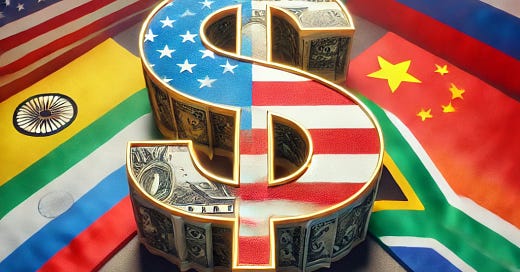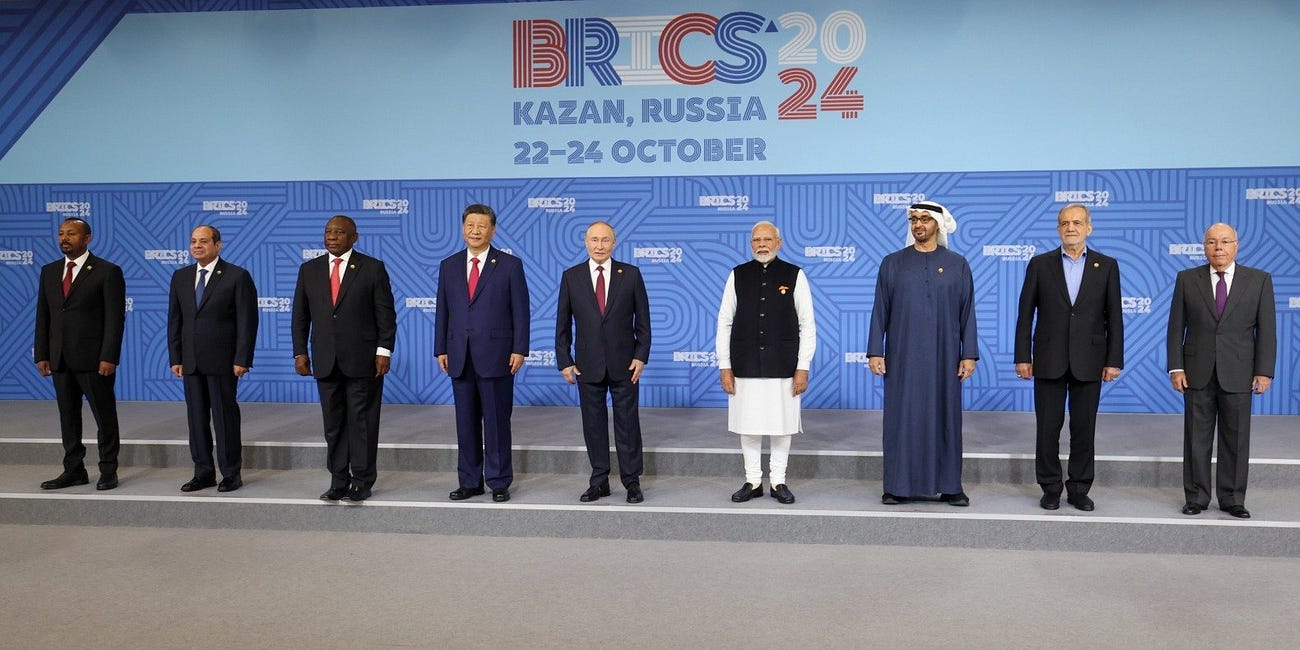India’s Currency Tightrope: Juggling BRICS, the Dollar and Crypto Coins
Rather than clinging to anti-dollar dogma or blind BRICS loyalty, India is quietly focused on forging a credible, interoperable rupee that can travel seamlessly across borders and digital platforms.
Navigating BRICS Ambition, Dollar Dominance and Digital Disruption
About the author
Karan Bir Singh Sidhu is a retired Indian Administrative Service officer (Punjab cadre) and former Special Chief Secretary to the Government of Punjab. An economist by training (M.A., University of Manchester), he brings the insights of nearly four decades of public service to his writing at the intersection of India’s foreign policy, trade and commerce, and the quest for rupee sovereignty.
1. From Early Enthusiast to Reluctant Partner
When the original four BRIC nations met at Yekaterinburg, Russia in 2009, India was an eager participant in calls for a more diversified global monetary order. The idea of a BRICS currency—a bold southern alternative to dollar dominance—was in alignment with India's long-standing push for reforms in global financial institutions. Fast forward to the present, and India now stands visibly apart from its BRICS peers, hesitant to proceed with a common currency. This policy pivot reflects a shift in geopolitical dynamics, economic prudence, and India's evolving strategic landscape.
2. Why New Delhi Slammed the Brakes
India's recalibration on a BRICS currency is driven by a confluence of strategic and economic factors. China's growing economic clout means any shared currency would inevitably tilt towards the yuan. India is also deeply invested in the Quad framework with the US, Japan, and Australia, and would be wary of joining a Beijing-led financial venture that could compromise its Indo-Pacific commitments. The Trump Administration’s pressure—through proposed tariffs and hardball trade negotiations—adds another layer of complexity. Domestically, the Reserve Bank of India remains protective of its monetary autonomy, recognising that inflation management, credit flows, and financial stability cannot be outsourced. Instead of tying itself to an untested multilateral unit, India prefers targeted currency corridors, localised de-dollarisation, and digital payment innovation through platforms like UPI.
3. Rupee-Settled Oil: Promise, Friction and Course Correction
India’s large-scale imports of discounted Russian crude after the Ukraine conflict presented a real-world test case for rupee settlements. Initially, India experimented with paying in rupees, but the inability of Russia to use those rupee balances for meaningful trade created friction. The workaround has been to switch to UAE dirhams routed through Dubai-based banks, allowing transactions to clear without triggering sanctions. It’s a solution that has kept oil flowing, ensured value for Indian refiners, and revealed both the promise and the limits of unilateral de-dollarisation. The RBI is now building capacity for on-shore dirham-rupee exchange to enhance oversight and reduce offshore exposure.
4. The Dubai Detour and Non-Oil Trade
Beyond crude oil, the Dubai clearing model has extended to Indian trade in coal, fertilisers, precious stones, and defence components. This system allows Indian exporters and importers to avoid the volatility and restrictions of dollar-based transfers, especially when dealing with sanctioned nations like Russia. The dirham, pegged to the dollar yet geopolitically neutral for both Moscow and New Delhi, has become a stabilising instrument. Indian banks and exporters are now replicating this model for other non-Western markets, particularly in Africa and Central Asia, building a parallel ecosystem that supports India’s growing trade ambitions without relying exclusively on Western financial channels.
5. Europe’s Euro Russian Gas Puzzle
Europe’s gas trade with Russia has shifted again. Direct euro payments to Gazprombank have effectively ceased under tighter recent U.S. secondary sanctions and new Russian decrees that bar “unfriendly-currency” transactions. Yet molecules still flow: a handful of EU members—chiefly Hungary and Slovakia—receive Russian gas rerouted through Turkey and settled via bespoke clearing houses that avoid euro wiring. Brussels has promised to end all Russian-gas imports by 2027, but that deadline faces push-back from energy-dependent capitals. The episode reaffirms two lessons India internalises: even the euro’s centrality can be disrupted by geopolitics, and large economies ultimately improvise around sanctions to secure energy—underscoring the value of keeping multiple, resilient payment channels open.
6. The Digital Rupee: India’s CBDC Experiment
India’s own central bank digital currency (CBDC), the e-rupee, is quietly emerging as a vital building block of its monetary future. Designed as a risk-free digital version of the rupee, the e-rupee differs fundamentally from both cryptocurrencies and the proposed BRICS currency. It is legal tender, issued and backed by the RBI, and seamlessly interoperable with India’s vast UPI payment ecosystem. Unlike Bitcoin or Ethereum, it is stable, centrally governed, and programmable—allowing targeted subsidies, rural disbursements, and even offline transactions in remote areas. India is also piloting cross-border usage of the e-rupee with partners like Singapore and the UAE. In essence, the digital rupee reinforces monetary sovereignty while providing a modern, scalable payments solution rooted in public trust.
7. Central Bank Money vs. Bitcoin: Threats and Opportunities for India
The rise of cryptocurrencies, especially Bitcoin, poses both opportunity and risk for India. On one hand, they offer the potential for faster cross-border remittances, greater financial inclusion for unbanked populations, and innovation in blockchain-based record keeping. On the other hand, their volatility, anonymity, and decentralised nature threaten capital controls, complicate inflation management, and enable financial misconduct. India’s response has been cautious: a flat 30% tax on crypto gains, a 1% tax deducted at source on every trade, and ongoing consultations on a regulatory framework. The government views its digital rupee as a controlled, sovereign alternative to private crypto—harnessing the benefits of digital finance without ceding regulatory control. As stablecoins pegged to the dollar or euro grow in usage, the challenge for India will be to ensure the e-rupee remains user-friendly, liquid, and globally recognised.
8. What if the BRICS Currency Proceeds Without India?
Should Brazil, Russia, China and South Africa proceed with a common BRICS currency, India is prepared for multiple outcomes. If it emerges as a limited-use settlement tool among sanctioned economies, India loses little. If it gains regional traction across the Global South, India may be compelled to join later—likely on tougher terms. If, against the odds, it evolves into a reserve currency that challenges the dollar or euro, India’s cost of borrowing could rise, and its influence in monetary governance could shrink. By staying engaged in BRICS deliberations—without jumping headfirst into implementation—India retains flexibility and safeguards its strategic interests.
9. Washington’s Bargain: Tariffs, Technology and Trade
The United States has made it clear that India’s economic and strategic decisions are under close scrutiny. While the Trump administration continues to press hard on reciprocal market access and has not hesitated to threaten steep tariffs, it has also extended a significant set of incentives. Through the U.S.–India COMPACT initiative and a newly inked ten-year defence partnership framework, Washington is offering India privileged access to sensitive military technologies—from co-production of next-generation jet engines to unmanned aerial systems, undersea platforms, and advanced electronic warfare capabilities. Coupled with a roadmap to double bilateral trade to $500 billion by 2030, the offer represents not just a commercial proposition but a strategic bargain. For India, the message is clear: build on tested partnerships that offer guaranteed tech transfer and market access, rather than risk entanglement in a BRICS currency initiative skewed toward China and fraught with geopolitical blowback.
9A. Operation Sindoor and the Modernisation Imperative
The urgency behind such partnerships was reinforced by Operation Sindoor in May 2025—a precision-strike campaign mounted in response to the Pahalgam terror attack. Though successful in its limited objectives, the operation revealed serious gaps in India’s defence inventory. The absence of long-range armed drones, hypersonic delivery systems, and advanced electronic countermeasures placed constraints on both mission flexibility and escalation control. Meanwhile, Pakistan has wasted no time in closing these very gaps with Chinese assistance, acquiring J-10CE fighters with AESA radars, CH-4 strike UAVs, upgraded short-range ballistic missiles, and sophisticated jamming pods. In a high-stakes neighbourhood where military advantage is transient and technology dictates tempo, India recognises that maintaining operational edge demands immediate access to the latest in battlefield innovation—something only robust, trusted partnerships can provide.
10. Balancing Act: Strategic Autonomy or Retreat?
Domestic critics accuse New Delhi of capitulation. The Government of India defends its approach as a calibrated exercise in multi-alignment. India remains an active voice in BRICS forums, advocating for fairer global governance and institutional reform. But it also invests in the Quad and bilateral partnerships to balance Chinese influence and attract Western capital and technology. The goal is not to pick sides, but to pick timing and instruments wisely—ensuring that India's sovereignty, rupee strength and strategic latitude remain intact.
11. The Road Ahead
India’s long game in global finance is not defined by ideological rejection of the dollar or emotional loyalty to BRICS. It is about building credibility, interoperability and reach for the rupee—across borders and technologies. To that end, India will continue to:
Broaden rupee-based trade corridors in South Asia, Africa and the Gulf.
Scale UPI globally and integrate with other fast-payment networks.
Expand central bank swap lines and contingency reserves.
Demand robust governance structures in any future BRICS currency framework.
In a fragmented world of rival financial systems and digital upheaval, India’s best defence is strategic agility. Sovereignty, not symbolism, remains the coin of the realm.





